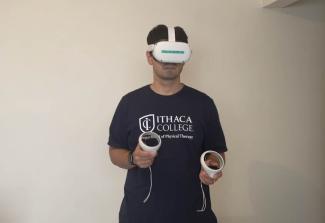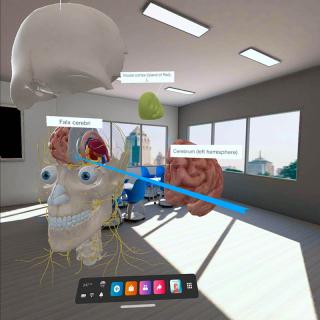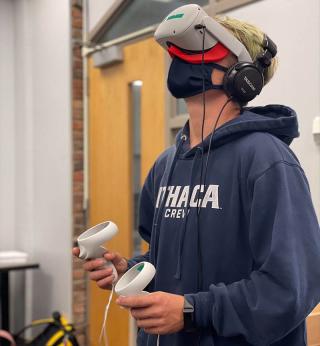“The experience makes me more excited for the integration of VR into higher learning,” said Mac Morean ’23. “It was definitely helpful for me, as a visual learner, to finally get to understand some of the structures that you can't really grasp from a textbook or a model.”
Beck is teaching from Brazil this semester and never imaged that he would be teaching this course overseas. He’s very thankful for how VR has allowed him to adjust his course.
“Using this innovative technology and trying to figure out new solutions to problems has been great,” he said. “We have noticed students having a greater understanding of neuroanatomy, learning from the 3D models on VR. During one of the VR sessions, I got myself thinking, ‘Wow, I’m teaching students overseas on a virtual environment. This is amazing! I really love what I’m doing here.’”
Jennifer Jolly, professor of art history, has used VR in her course Latinx Art in the United States, using the technology in conjunction with Google Earth and having students visit places like Los Angeles and San Diego, all from South Hill.
“While the classroom is a great place to project images and details and really analyze the images themselves, what you don't get in that context is a larger sense of space, a larger sense of how these murals fit into the urban environment and that's such an important theme that we're studying in the class, how do works of art interact with communities,” said Jolly. “VR takes us a step closer to being able to do that.”
Jolly typically sends her students two at a time for about 20 minutes to get introduced to the technology and sets up with the lab ahead of time a series of three different sites to visit. Students walk around the neighborhoods to look at the murals and then write a reflection about the experience afterwards.
“The experience was beneficial in better understanding the full impact that murals have on their community,” said Josephine Horchler ’21. “A photograph can only convey so much about the murals’ context. Getting to ‘walk around’ the site of the murals helped me better understand their meaning and connection to the community. I was able to gain a better sense of the murals’ scale, relation to their site, and how people interact with them, which are all things that aren’t easily understood from photographs.”
“It was fascinating putting the headset on for the first time,” said Jolly. “It really is remarkable to start in one spot, and then you swivel and can see in all these different directions. The experience of looking around is very clunky when you're just using Google Earth without the headset, so when you get to do it with the headset it really changes how you perceive the space.”




